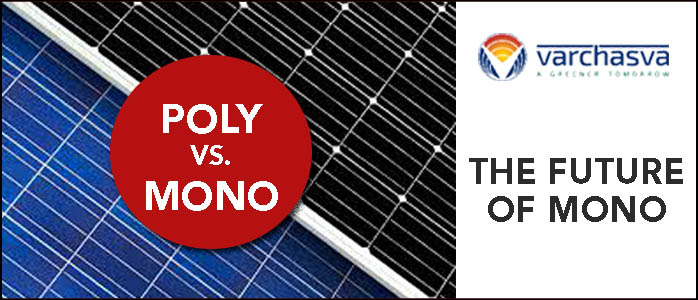- Events
- >
- Single Events
Varchasva Energy Pvt. Ltd.
- Varchasva energy is well equipped with qualified energy professionals with a collective experience of over 10 years. We are a team of solar enthusiasts with technological innovations underlining the focus on quality services and all round support. Varchasva takes on charge and commitment towards the development of eco-friendly technologies with innovative and futuristic energy solution. We, at Varchasva, recognize the importance of every step taken towards building a greener and safer future. By harnessing the inexhaustible energy of the sun, we offer efficient and advanced solutions for energy requirements for today and tomorrow.
Inquiry Now


Varchasva Energy Pvt. Ltd.
Posted on : 24 Nov 2024 04 : 39 : 29 pm
By : vaibhav.ujjain@varchasva.co.in
The Future Of Mono
With the price difference fading between the monocrystalline and polycrystalline PV module technologies, we feel that mono is sure to become the future of the solar power development in India - this is what the top 3 PV module suppliers to India, had to say to reporters recently when quizzed about the future of mono in India. At present, three China-based manufacturers, Canadian Solar, JA Solar, and Trina Solar are the top three PV model suppliers to India. According to the sales manager of JA Solar, Victor Liang, it is the polysilicon modules that have been dominating the Indian market till date. This dominance has a lot to do with the customer belief that the cost to efficiency ratio can best be achieved with poly. However, with the new technology coming in vogue, chances that very soon Indians would begin to accept Mono-PERC modules. Mono-PERC has already proven its efficiency in the solar markets of China, USA, and Asia-Pacific. With the price gap between mono-perc and polysilicon models becoming narrower, there are high chances that Mono-PERC will start grabbing its share of the Indian Market starting this year. According to Yan Zhuang, the president and COO of Module and System Solutions of Canadian Solar, Indian market is still very price-driven and less tech-savvy. The price pressure often makes it harder for the manufacturers to ship hi-end products at low prices to India. Nevertheless, with the PPA price (and its safeguard duty) coming down, the focus of the PV players may now shift towards better performance. If not this year, at least by 2020, it’s expected that solar project developers in India will start looking for value in newer technologies to save up on long-term costs. Zhuang believes that the share of Mono in the Indian market will rise, but poly will also remain in demand. He feels there is space for both in India. As of now, only a few represent Mono wafer capacity. Even if they do get aggressive with their pricing, they may not be able to sustain the race for long. So, ultimately the price point of Mono and Poly wafers will determine what technology will rule the roost in India. Gaurav Mather, the sales director of Trina Solar, India, we can safely assume that the price gap between Mono and Poly may come to its lowest during the second half of 2019. Although Mono-PERC might appeal to a few early adopters of better technology, who may be looking at LCOE, it is Poly that will continue to be the mainstream in India. All said and done, the focus of solar project developers in India is slowly but steadily shifting towards efficiency and newer technologies. While Mono is definitely an option, technologies such as Bifacial that help reduce the BOS (Balance of System) as well as land costs of solar projects are also becoming popular. Cost-efficiency will however always remains the key driving interest for solar project developers and adopters in India.